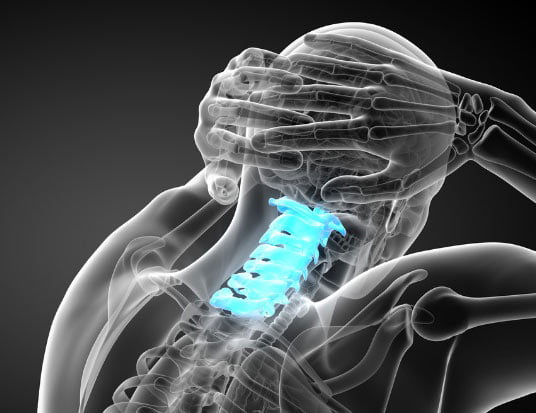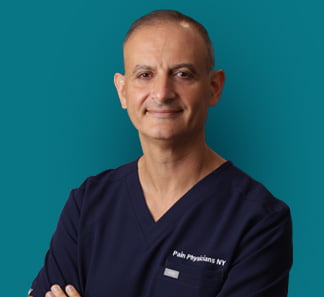There are so many conditions and situations that lead to back pain that it’s vital you receive a correct diagnosis to get the best treatment. Are you searching for “pain management near me“? Our top back pain doctors are experts at spotting the symptoms that may indicate you’ve developed stenosis of the neck. The condition can drastically reduce your quality of life, so don’t wait to seek treatment. Call today for an appointment.
Spinal stenosis causes a narrowing of the spaces within your spine. This narrowing can compromise surrounding tissue, compress nerves and cause significant discomfort. Most often, the condition occurs in one of two places:
- In your neck, where it’s called cervical stenosis
- In your lower back, where it’s called lumbar stenosis
Some individuals have spinal stenosis of the neck with few or no symptoms, but others experience noticeable frustrations that can worsen over time. Most commonly caused by normal age-related wear-and-tear, neck stenosis can degrade your quality of life when the pain hits. But the top-rated back pain specialists in NYC center for pain management have several treatment options to provide relief and help you manage your symptoms.
Causes of Neck Stenosis
The bones of your vertebrae form a canal in which multiple nerve strands and your spinal cord flow. While normal aging is the most common cause, other factors may contribute to this narrowing and discomfort, such as:

- Genetics. Your family may have a tendency toward small spine canals. If this is the case, any injury or changes in your spinal tissue can trigger stenosis symptoms.
- Growths, whether benign or malignant, can intrude on the spinal canal space, causing many of the recognized stenosis in the neck symptoms.
- Disease. Paget’s disease and other diseases can cause an overgrowth of bone that impinges on nerves as it grows into spinal spaces.
- Injuries. Any kind of significant trauma due to an accident, fall or blow to your cervical spine can cause a narrowing of the spinal canal.
- Herniated discs. When the cushioning gel of a spongy disc leaks out, that material may encroach into the narrow areas of the spine.
- Thickening ligaments. The protective cords around your spinal column may thicken due to injury or age and begin blocking the spinal spaces.
Symptoms Requiring Neck Stenosis Treatment
 Spinal stenosis of the neck can mimic other painful conditions, which is why you need the best pain management doctor in New York. The team at Pain Management NYC uses a multi-pronged approach for diagnosing your discomfort. The most common symptoms produced by neck stenosis include:
Spinal stenosis of the neck can mimic other painful conditions, which is why you need the best pain management doctor in New York. The team at Pain Management NYC uses a multi-pronged approach for diagnosing your discomfort. The most common symptoms produced by neck stenosis include:
- Growing weakness, tingling or numbness in one or both arms, hands, legs and feet because the nerve that’s affected travels through your spine to other parts of your body
- Persistent neck pain that isn’t relieved by rest or stretching
- Difficulty maintaining your balance and trouble walking steady
- Bladder and bowel issues in very severe cases
As you age, it’s more likely these symptoms indicate spinal stenosis, but you can develop similar symptoms caused by other back conditions, such as:
Diagnosis of Spinal Stenosis in the Neck
Your pain specialist always performs a thorough physical exam to check your sensations, reflexes, mobility and flexibility as a way to understand your pain and other symptoms. Your consultation includes a detailed medical history and information about your family background to give him a full picture of your health and situation.
Occasionally, imaging tests and blood work are required to rule out infections and other diseases. They also help to better detect where the narrowing is occurring. X-rays, CT scans and MRIs are often used in these cases. Nerve tests may also be requested to understand how the narrowing is affecting different nerves in your neck, shoulders, arms and other areas.
Neck Stenosis Treatment
Treatment starts conservatively, although it may require quick escalation, depending on the severity of your symptoms. If your symptoms are mild or you aren’t experiencing noticeable signs of stenosis, your doctor may take a wait-and-see approach. It’s essential that your condition is monitored, however, due to potential complications if your stenosis in the neck progresses. Treatment options include:
- Medications, such as over-the-counter pain relievers, anti-inflammatory medicine or even prescription pain medication, if necessary
- Hot and cold packs to help numb pain and relax tight and cramped muscles and ligaments
- Physical therapy to address weakened muscles, a lack of flexibility and poor balance and posture
- Cortisone injections that provide significant relief by blocking pain, reducing inflammation, and helping you stretch with less discomfort
- A decompression procedure that removes portions of a ligament with tiny, needle-like instruments, if necessary
Several minimally invasive surgical options offer your top rated neck pain doctors in New York the option of providing relief by making small holes in the canal, placing hinges in your cervical spine, fusing certain vertebrae together or replacing degenerated discs. These methods are reserved for more severe cases, used only after other options have proven unsuccessful.
After Your Successful Treatment
Once your pain is reduced, you receive instructions to prevent further discomfort and to help you maintain as much flexibility and mobility as possible, such as:
- Neck-stretching exercises
- Relaxation techniques
- Diet advise on maintaining a healthy weight
- Good posture and lifting techniques
- Smoking cessation
Don’t wait for your neck pain to improve on its own. Get an accurate neck stenosis diagnosis and fast, effective treatment for your pain and other symptoms by contacting Pain Management NYC.

Boleslav Kosharskyy, MD, is a top-rated, best-in-class interventional pain management doctor. He is board-certified in Anesthesiology, Interventional Pain Medicine, and Palliative Care.
Dr. Kosharskyy is an Associate Professor of Anesthesiology and Rehabilitation Medicine at Albert Einstein Medical College. He’s also the Associate Medical Director of Pain Medicine and Director of Anesthesia for the Joint Replacement Center at Montefiore Medical Center and Albert Einstein Medical College.
He is an active member of the American Society of Anesthesiology (ASA), the American Society of Regional Anesthesia and Pain Medicine (ASRA), and the New York State Society of Anesthesiologists (NYSSA)
